Among the many flooring options available today, vinyl flooring has surged in popularity, and for good reasons. It offers versatility, durability, and aesthetic appeal, often at a fraction of the price of traditional flooring materials like natural wood. But within the realm of vinyl itself, there exists a plethora of types, each boasting its unique features. This article delves into six prominent vinyl flooring types, elucidating their characteristics to aid in your decision-making process.
Vinyl Sheets
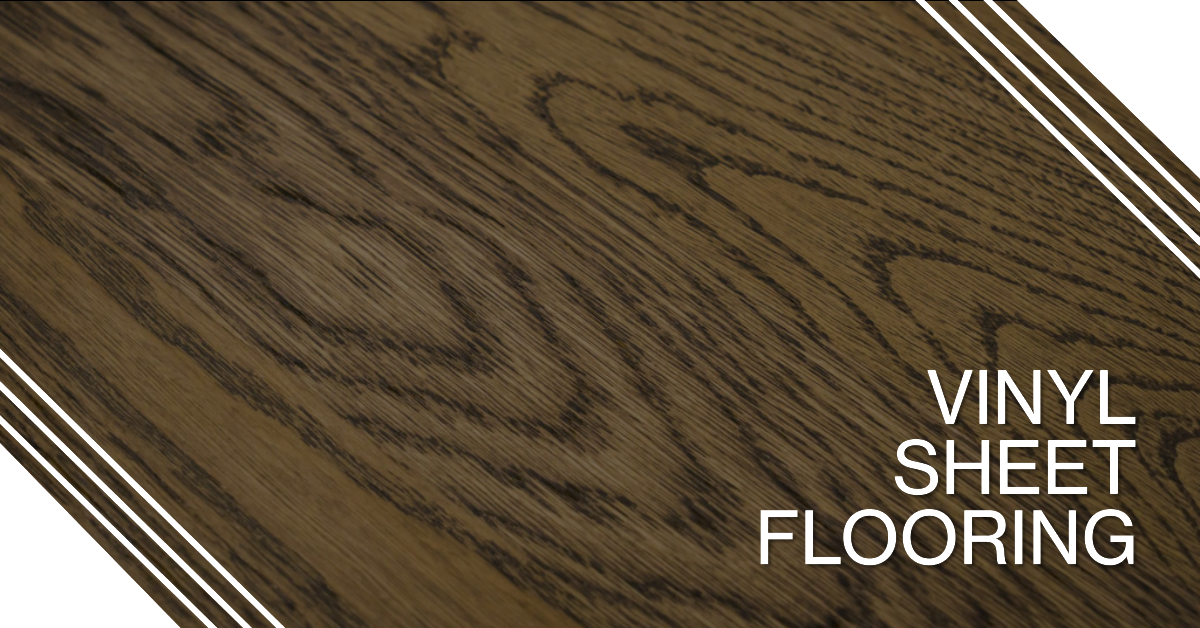
Sheet Vinyl Flooring Type
Vinyl sheet flooring is a continuous roll of material, providing a seamless finish in a room. It is often made up of multiple layers: a backing material, a core layer, fibre-glass to keep the sheet flat, a decorative layer, and a protective layer, usually made from urethane, which offers surface protection from scratches and spills.
Advantages of vinyl sheets include their water resistance, making them suitable for wet areas like bathrooms and kitchens. They’re also relatively affordable and can mimic a range of natural materials like wood and stone. Disadvantages, however, encompass the challenge of repairing them – if one section gets damaged, often a large section or the entire sheet might need replacement. Additionally, while installation can be quicker due to the large sections, it does require precise cutting to ensure a snug fit.
For maintenance, vinyl sheets are straightforward. Their seamless design means fewer grooves for dirt to accumulate. Regular sweeping and occasional mopping with a mild cleaner keep the surface gleaming. Avoid abrasive tools which might scratch the protective layer.
Click Vinyl Tiles
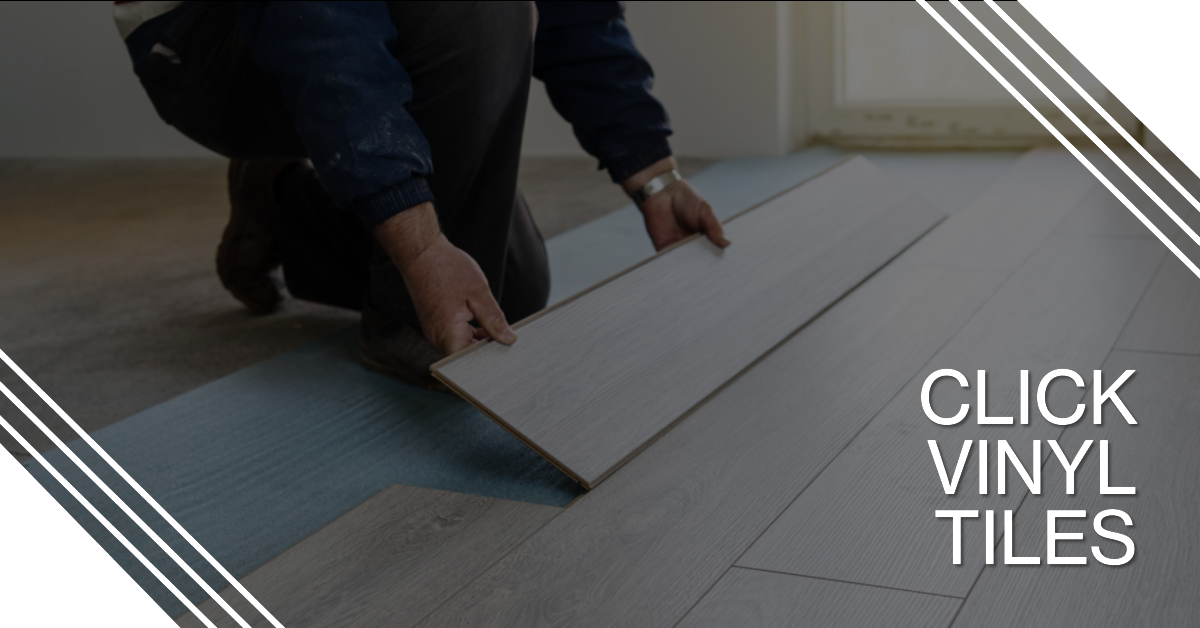
Click Vinyl Tile Flooring Type
Click vinyl tiles come with interlocking edges that can be easily “clicked” into place, reminiscent of laminate flooring systems. The tiles consist of several layers, including the vinyl core, a printed design layer, and a protective wear layer. Their multi-layer composition offers durability and an authentic look.
The benefits of click vinyl tiles are their ease of installation, even for DIY enthusiasts, and the ability to replace individual tiles if they become damaged. They also offer a level of flexibility in design due to the individual tile format. On the downside, while water-resistant, the seams between tiles can be vulnerable to moisture ingress, especially if not installed tightly.
Caring for click vinyl tiles involves regular sweeping to remove debris. Mopping with a mild detergent helps in retaining their shine. It’s crucial to wipe spills promptly to prevent seeping through seams.
Self-Adhesive Vinyl Tiles
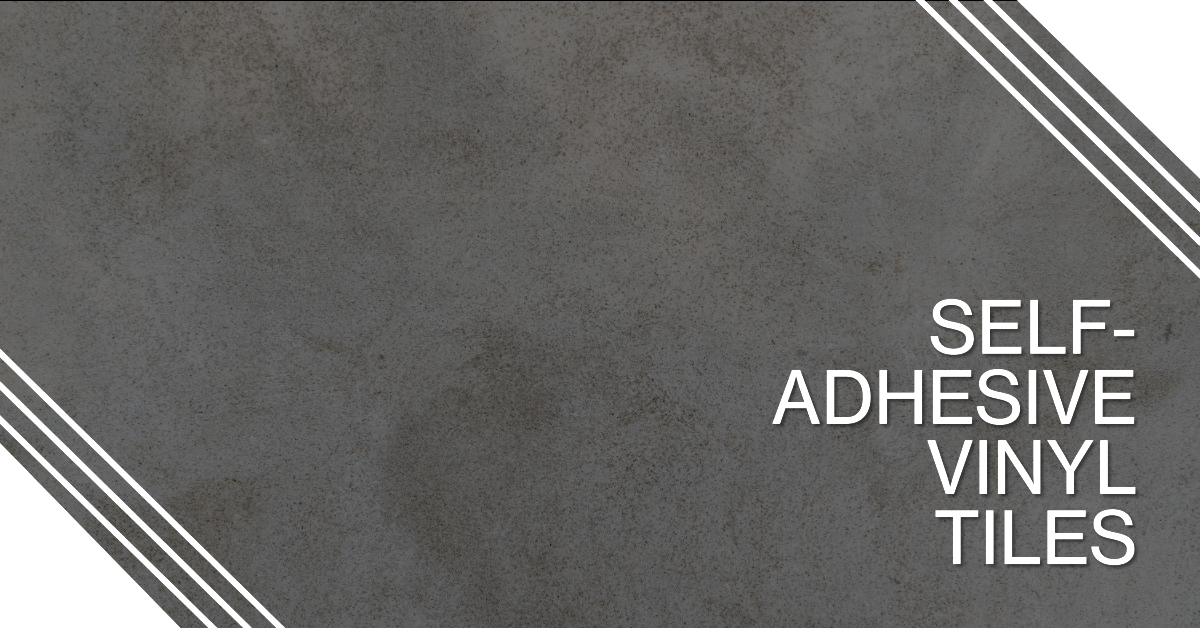
Self-Adhesive Vinyl Tile Flooring Type
Self-adhesive vinyl tiles come with a pre-applied adhesive backing, eliminating the need for a separate adhesive application. Like other vinyl options, they have a multi-layered structure which includes a design layer and a protective top layer.
The primary advantage of self-adhesive vinyl tiles is the ease of installation – simply peel and stick. This makes for a speedy installation process. However, the downside is that the adhesive quality can vary, potentially leading to tiles lifting over time. Moreover, subfloor preparation is crucial; any imperfections can be telegraphed through the tile.
Maintenance requires regular sweeping and mopping with a mild cleaner. Direct sunlight can weaken the adhesive over time, so using blinds or curtains is recommended in sunny areas.
Glue-Down Vinyl Tiles
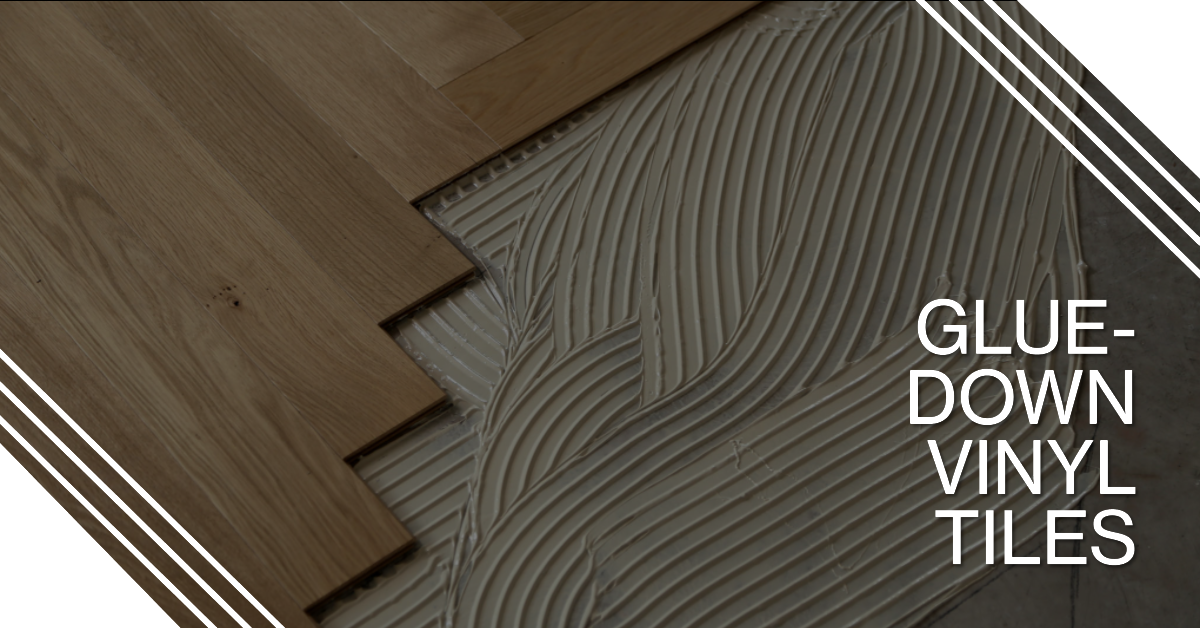
Glue-Down Vinyl Tile Flooring Type
Glue-down vinyl tiles require an adhesive to be manually applied to the subfloor or the back of the tile before installation. These tiles, similar to others, comprise multiple layers for durability and aesthetics.
The strength of glue-down vinyl tiles is their stability. Once they’re adhered, they’re unlikely to shift, making them ideal for high-traffic areas. They also provide a closer bond to the subfloor, reducing the chances of gaps or seams opening. However, the installation process is more laborious and time-consuming than other options, and removing them can be challenging.
Maintaining glue-down tiles is similar to other vinyl options: regular cleaning with a soft broom and damp mopping. Avoiding excessive water during cleaning ensures the adhesive remains effective.
Click Vinyl Planks
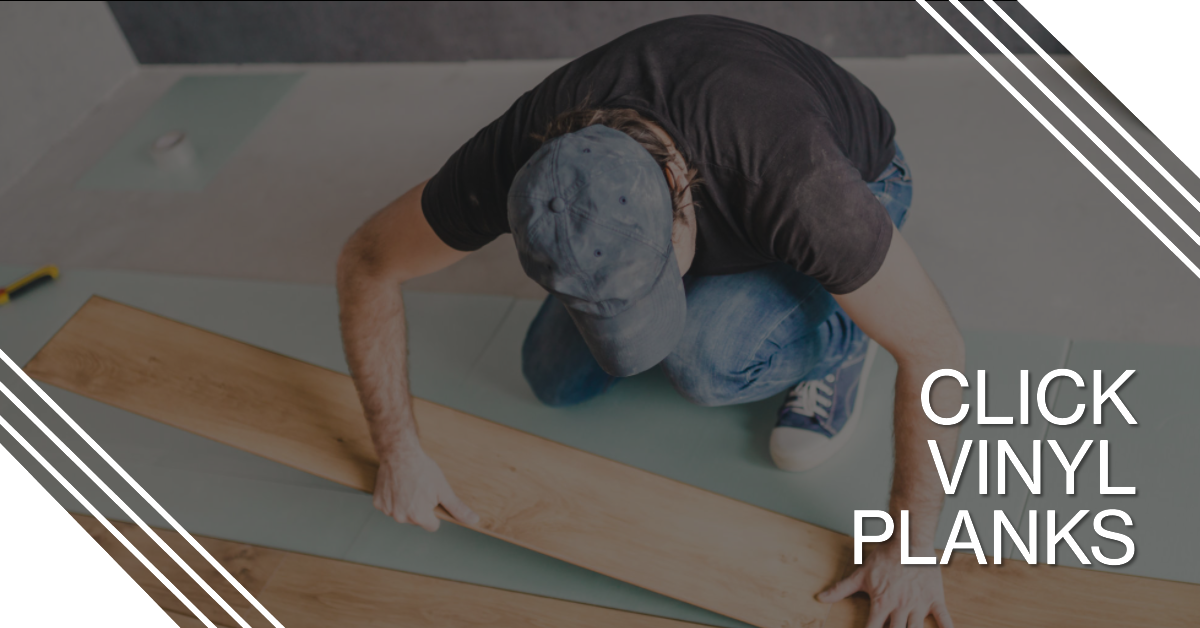
Click Vinyl Plank Flooring Type
Click vinyl planks are similar to click vinyl tiles in their interlocking design but are shaped as planks to replicate wooden floorboards. They typically include layers such as a wpc or spc vinyl core, a decorative wood-look layer, and a protective top layer.
Among the benefits of click vinyl planks is the authentic wood appearance they can provide at a fraction of the cost of real wood. Their click-system also facilitates a simpler installation process. However, as with click tiles, the seams can be vulnerable to moisture if not perfectly joined, and while they mimic wood, they don’t offer the same tactile feel or warmth.
For upkeep, regular vacuuming or sweeping is ideal. Using a damp mop with a mild detergent maintains their shine, but it’s vital to ensure no water seeps into the seams.
Loose-Lay Vinyl Planks
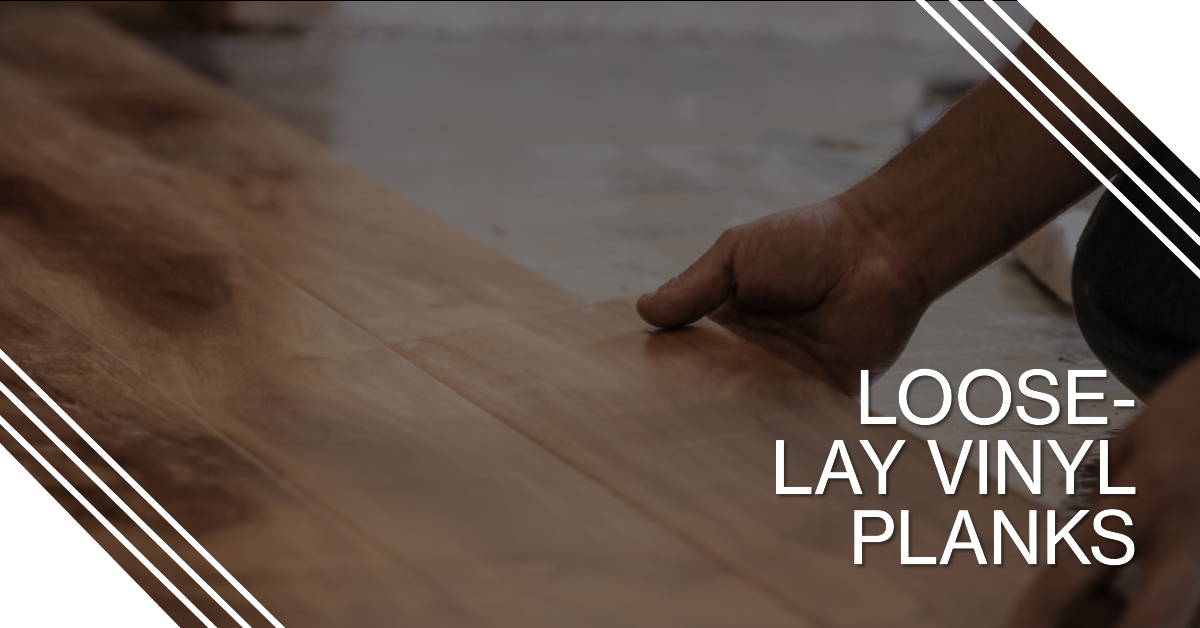
Loose-Lay Vinyl Plank Flooring Type
Loose-lay vinyl planks are unique in that they don’t rely on clicking systems, glue, or adhesive. They’re designed to lay flat on the subfloor, held in place by their weight, and the friction of their backing. Like other vinyl formats, they possess a layered composition, with design and protective layers.
The main advantages of loose-lay vinyl planks are the ease and speed of installation and the ability to easily remove or replace planks without much hassle. They’re also adaptable to imperfections in the subfloor. However, in large open areas or under heavy furniture, they might require some adhesive to prevent movement, and they might not be as secure as other fixed installation methods.
Maintenance involves standard sweeping and mopping. Due to their weighty nature, they’re less prone to shifting during cleaning. However, ensuring they lay flat and free from ripples will prevent dirt from gathering underneath.
Vinyl Flooring Types Compared
| Feature / Type | Vinyl Sheets | Click Vinyl Tiles | Self-Adhesive Vinyl Tiles | Glue-Down Vinyl Tiles | Click Vinyl Planks | Loose-Lay Vinyl Planks |
|---|---|---|---|---|---|---|
| Description | Continuous roll of material | Interlocking edges | Pre-applied adhesive backing | Manual adhesive application | Interlocking design, plank form | Lay flat without adhesive |
| Layers | Multiple (5 typical) | Multiple | Multiple | Multiple | Multiple | Multiple |
| Installation Ease | Moderate (precise cutting) | Easy (DIY friendly) | Very Easy | Time-consuming | Easy | Very Easy |
| Water Resistance | High | Moderate (seam vulnerability) | Moderate | High | Moderate (seam vulnerability) | Moderate |
| Damage Repair | Hard (large sections) | Easier (tile by tile) | Easier (tile by tile) | Moderate | Easier (plank by plank) | Easiest (plank by plank) |
| Look Variety | Natural materials mimic | Authentic look | Varies | Varies | Wood mimic | Varies |
| Maintenance | Sweep & mild mop | Sweep, mild mop, wipe spills | Sweep, mild mop, sun protection | Sweep & damp mop | Sweep, damp mop, avoid water seep | Sweep & mop |
| Pros | Water resistant, affordable, seamless | Easy installation, flexible design, tile replacement | Easy installation, no additional adhesive | Stable, close bond to subfloor | Authentic wood look, easy installation | Fast installation, easy replacement |
| Cons | Hard to repair, precise installation | Seam moisture vulnerability | Adhesive variability, imperfection telegraph | Laborious installation, hard removal | Seam moisture vulnerability, tactile difference from wood | Potential movement, may need adhesive in large areas |
Why Vinyl Flooring?
Vinyl flooring has swiftly emerged as a preferred choice for many homeowners and businesses as an alternative to real wood, largely attributed to its array of undeniable benefits. Foremost, vinyl is exceptionally cost-effective. Compared to traditional flooring materials like hardwood (solid or engineered), vinyl provides a cost-efficient alternative without compromising too much on aesthetics. The plethora of styles and designs available ensures that vinyl can mimic more expensive floor types, such as wood, tile, or marble, with striking accuracy. Whether one seeks the warm appearance of oak or the cool elegance of slate, there’s likely a vinyl product that captures that essence.
Furthermore, the durability of vinyl is noteworthy. Engineered to withstand daily wear and tear, it proves resilient against scratches, dents, and stains, making it an ideal choice for high-traffic areas in homes or commercial spaces. Its layered construction often includes a wear layer on the surface, offering additional protection against spills and potential damage. In terms of care and maintenance, vinyl’s ease of cleaning amplifies its appeal. Simple routine measures like sweeping, coupled with occasional damp mopping using mild cleaners, keep vinyl floors looking pristine. This ease of care translates to time savings and reduced long-term maintenance costs.
The installation flexibility vinyl offers is yet another feather in its cap. Designed to be adaptable, vinyl flooring can be laid over various subfloors, including concrete, old tiles, or wood, providing they are level and in good condition. This adaptability means renovation projects can progress more rapidly, eliminating the often laborious step of subfloor preparation. Additionally, certain vinyl options present DIY-friendly installation methods, allowing homeowners to potentially bypass the costs of professional installation.
Then there’s the comfort factor. Unlike some hard surfaces that can feel cold underfoot, vinyl tends to retain warmth, offering a more pleasant tactile experience. This characteristic, combined with its sound-absorbing properties, makes spaces feel cosier and quieter. Additionally, for households or establishments concerned with allergens, vinyl doesn’t harbour dust mites or allergens as some porous materials do, contributing to a healthier indoor environment.
Conclusion
Selecting the right flooring can significantly influence the comfort, aesthetics, and utility of any space. With vinyl flooring’s rise in the interior decor landscape, understanding the nuanced differences between its various types becomes crucial. Whether prioritising ease of installation, durability, or visual appeal, there’s a vinyl option tailored to meet those needs. Armed with the insights from this article, you are better positioned to make an informed choice, ensuring that the selected vinyl flooring type perfectly complements the intended space’s requirements and ambiance.
—
FAQ
What are the key layers found in vinyl sheet flooring?
Vinyl sheet flooring typically consists of multiple layers: a backing material, a core layer, fiberglass to keep the sheet flat, a decorative layer, and a protective layer usually made from urethane, which offers protection against scratches and spills.
How does the installation ease of self-adhesive vinyl tiles compare to glue-down vinyl tiles?
Self-adhesive vinyl tiles offer ease of installation as they come with a pre-applied adhesive backing and are simply peel-and-stick. On the other hand, glue-down vinyl tiles require manual application of adhesive to the subfloor or the back of the tile, making the installation process more laborious and time-consuming.
Are click vinyl tiles completely water-resistant?
While click vinyl tiles are water-resistant, the seams between tiles can be vulnerable to moisture ingress, especially if they are not installed tightly.
What are the advantages of loose-lay vinyl planks over other types?
Loose-lay vinyl planks don’t rely on clicking systems, glue, or adhesive. They are designed to lay flat on the subfloor, held by their weight and the friction of their backing. This allows for easy and speedy installation and the ability to quickly remove or replace planks without much hassle.
Why is vinyl flooring considered a cost-effective option compared to traditional materials?
Vinyl flooring provides a cost-efficient alternative to traditional flooring materials like hardwood or stone without compromising too much on aesthetics. Vinyl can mimic more expensive floor types such as wood, tile, or marble with remarkable accuracy, offering a range of styles and designs at a fraction of the cost.








